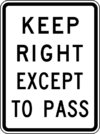thomas-dash
Active Member
- Joined
- Sep 7, 2021
- Messages
- 245
- Reaction score
- 95
- Location
- United States
- Country
- United States
- Dash Cam
- Viofo A129 Pro Duo 4k, Viofo MT1
I was passing a semitruck and a Ford F-150 in a section of the road that temporarily had a lane for passing. There was an arrow indicating the lane was about to end when I almost got past the semi. I should have backed off and abandoned my overtake, but I knew I had enough room to pass the F-150 as well before the lane ended. However, I didn't expect the F-150 to merge into my lane so early. I'm not sure if the F-150 driver did it intentionally or just didn't check their side mirrors.
I could have merged between the F-150 and the semi, but I didn't like that option too much. I didn't want to go back behind the semi because it had already kicked up a rock and chipped my windshield a few minutes prior. In hindsight the best thing to do would have been to back off when the first arrow appeared on the pavement and try to pass again in the next section of the road with a passing lane.
I could have merged between the F-150 and the semi, but I didn't like that option too much. I didn't want to go back behind the semi because it had already kicked up a rock and chipped my windshield a few minutes prior. In hindsight the best thing to do would have been to back off when the first arrow appeared on the pavement and try to pass again in the next section of the road with a passing lane.




